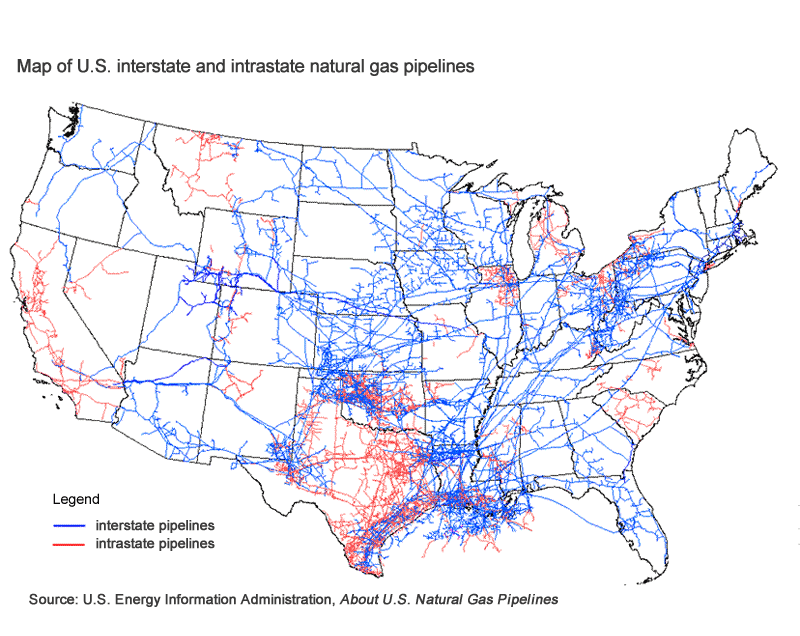Pipelines may be necessary at various stages of oil and gas production. They are generally one of three types: those built within the oil and gas fields for the collection of oil (infield lines), those built to cover longer distances between the point of production and consumption (cross-country pipelines) and smaller diameter, low-pressure pipelines used for distribution and supply (usually natural gas). Except for the low-pressure distribution and supply pipelines, the traditional material used in construction is high tensile steel. However, pipelines correspond not only to the pipes, but also with all the associated apparatus that makes up the system, including valves, tees, pig traps, pumps or compressors and other miscellaneous infrastructure.
From an environmental perspective pipelines can be both a blessing and a curse. In the best scenarios, a well-designed pipeline can service multiple well pads mitigating the need for truck traffic, pollution from diesel engines, and increased damage to roadways. They are generally believed to be the safest means of transporting large quantities of hazardous fluids and gases over long distances. There is a reduced likelihood of accidents and spillage of products, and the environmental impact of operating pipelines is less than for rail or road transport. In the worst scenario, pipelines introduce a greater risk for spills through pipeline leaks and widen the footprint of oil and gas operations substantially. Pipelines can fail through material defect, corrosion, natural causes (e.g. earthquakes) and third-party interference.

A previous lesson detailed some of the best practices for managing erosion pertaining to both oil and gas production sites and pipeline rights of way. This lesson outlines some of the best management practices for unique cases not encountered in traditional construction. It is standard practice for environmental impact assessment to begin during the preliminary design stage of a pipeline project. By utilizing the right design, construction, materials and restoration techniques, a pipeline may be built in almost any environment.
Information needed at the design stage is frequently available commercially as digital data, which can be assessed by aerial photography or mapping within a geographic information system (GIS). Following an initial gathering of data, consultation with organizations that have a responsibility for environmental protection at national, regional, and local levels can assist in the identification of areas that may require mitigation or protection and should form an important part of the assessment process. The overall process should lead to the identification of all major sites of environmental interest. Once the principal features affecting the pipeline route have been identified, the role of the environmental assessment is to identify in detail the possible impacts of the proposal, identify suitable mitigation measures, and include mitigation measures into the design. Upon approval, the construction can begin. Below is a list of the scenarios the pipeline construction may encounter.
Wetland Crossings
Pipelines may cross sensitive wetland habitats incurring a new collection of challenges. Because movement of vehicles across wetlands should be limited at all times, the staging site for all construction equipment and materials must be outside of the habitat. Further, best practices for reclamation in wetland environments differs from those used on dry land. Excavated topsoil should be stockpiled separately from subsoil and reapplied to the disturbed sites without fertilizer and without grass seed as it is inappropriate for the habitat.
Road Crossings
The best-case scenario for constructing a pipeline over a road is when the road drainage system is dry. If runoff is present, surface water should be diverted around the trench with a culvert or flume. Water bars should divert all surface runoff from the trench site, and sediment barriers should surround any soil storage while awaiting trench refill.
Stream Crossings
Best management practices for pipeline construction across stream crossings take into account the water that is flowing through the same space the pipeline is to occupy. To minimize the risk of sedimentation, for construction projects lasting longer than a day, the stream should be diverted over the site of a trench using a culvert or a flume. The pipeline should cross the stream perpendicularly to minimize stream disturbance. Excavated material stockpiles should be encircled with a sediment barrier to prevent sedimentation of the stream. Upon completion, the bank and all disturbed areas in and around the stream and pipeline should be stabilized with vegetation.
This list is not intended to be exhaustive nor is it intended to be a reference but rather a conceptual introduction to ways of thinking about pipeline construction management practices. Specific regulations vary from state to state, and state departments of environmental protection author and publish state-specific guidelines.
During normal operation, there should be no significant impacts on the environment resulting from a pipeline. Today’s pipelines have sophisticated loss monitoring detection systems1Orszulik, S. T. (Ed.). (2008). Environmental technology in the oil industry. Springer.. This kind of system enables early detection of leaks, and allows the operators to shut down the pipeline, identify the location of the leak and isolate it by shutting off block valves on either side. The system is continually checked to ensure failures are identified and rectified. Also built into the pipelines are sensors to anticipate and detect corrosion. Pipelines are protected from corrosion by the application of a protective coating or wrapping in the factory. Finally, pipeline integrity can be further maintained by regular internal checks using a remotely operated spherical or cylindrical pig.
Even with these recent advances, public concern over the state of our environment has triggered a proliferation of legislation designed to minimize the environmental impact caused by new and old pipelines. Regulations require all pipeline operators to have plans that can be acted upon in an emergency. These clearly state the line of responsibility in such an event and detail what will happen. Emergency response vehicles containing necessary equipment are held by the operators at convenient locations, and regular training is given to the staff involved. The emergency services should also be familiarized with the plans.
Images: “Pipeline Construction Site” by Sergey_R via Shutterstock


